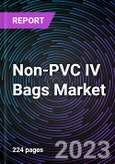This report comes with 10% free customization, enabling you to add data that meets your specific business needs.
Based on Product Type
- Single Chamber
- Multi Chamber
Based on Material Type
- Polypropylene IV Bag
- Polyethylene IV Bag
- Others
Based on End User
- Hospitals
- Ambulatory Surgical Centers
- Others
Based on Region
- North America
- Europe
- Asia Pacific
- Rest of the World
The material type segment is categorized into Polypropylene IV Bag, Polyethylene IV Bag and Others. Where, the polypropylene IV bags segment is dominating the market and is also likely to remain dominant over the non-PVC IV bags market forecast period. This can be ascribed to the requirement for enhanced patient safety, increased environmental sustainability, provision of improved clinical outcomes cost-effectiveness and regulatory pressure.
As per the end users the market is segmented as Hospitals, Ambulatory Surgical Centers and Others. The hospital end user segment is likely to hold the major share in the market growth. This is due to the rise in concerns regarding the safety and environmental impact of PVC.
The geographical market is divided into North America, Europe, Asia Pacific and Rest of the World. As the North America region In the United States, strict regulations aimed at enhance the patient safety which have surged the demand for non-PVC IV containers, which offer patient treatment without risking harm. Further, the demand for IV bags has increased majorly as the prevalence of stomach cancer has increased over the past few years in United States.
Global market is significantly driven by the growing incidences of hospital-acquired infections (HAIs) among the population. Along with the rising number of patients requiring intravenous antibiotics across healthcare facilities, this has given a boost to the demand for non-PVC IV bags. Moreover, the rising adoption of single-chambered non-PVC IV bags in IV drips and other mixtures owing to their easy of management, transportation, and disposal is highly leading to the product sales across the world. In addition to this, the surging number of point-of-care (POC) facilities across the world and the preference for home care setups, especially for the old population, is favorably impacting the global market growth.
The non-PVC IV bags market research report presents analysis and overview of the key market competitors which include JW Life Science, Shanghai Solve Care Co Ltd., ANGIPLAST PVT. LTD, B. Braun Melsungen AG, Baxter, PolyCine GmbH, Pfizer, Inc (Hospira), Fresenius Kabi AG, RENOLIT, and Sealed Air.
Henceforth, the inclination towards non-PVC IV bags represents a vital trend in the healthcare industry, since it reflects an increasing awareness of the requirement to prioritize patient safety and environmental sustainability in the development and use of medical devices.
Key reasons to purchase the report:
- Impacting factors which are fostering the demand and latest trends running in the market are provided in the report.
- Non-PVC IV bags market forecast for global market split into segments such as region, substrates and applications are mentioned in the study.
- This study further presents the analysis of new product launches, mergers and acquisitions and research and developments of the key competitors.
- The penetration of non-PVC IV bags market across the four geographical regions is also elucidated in this report.
Table of Contents
Companies Mentioned
- JW Life Science
- Shanghai Solve Care Co Ltd.
- ANGIPLAST PVT. LTD
- B. Braun Melsungen AG
- Baxter
- PolyCine GmbH
- Pfizer, Inc.
- Fresenius Kabi AG
- RENOLIT
- Sealed Air








